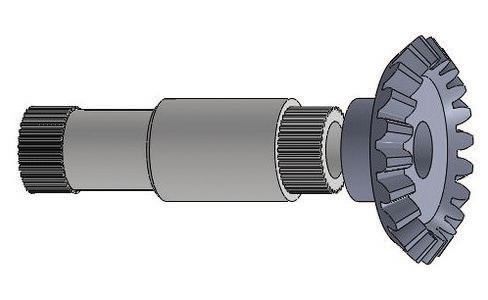Sustainable manufacturing
Dr. Neil Canter, Contributing Editor | TLT Tech Beat February 2016
A six-step methodology enables manufacturers to evaluate different production processes through quantification of sustainability metrics.
KEY CONCEPTS
•
With demand for sustainable manufacturing growing, one problem is how best to quantify this process.
•
A six-step methodology has been devised to quantify sustainability metrics.
•
This strategy has been used to determine which of three pathways for making bevel gears generates the best sustainability performance.
SUSTAINABILITY IS ONE OF SEVERAL TERMS THAT define more environmentally favorable or green processes, but it also encompasses ensuring economic viability and social responsibility. In a previous TLT article, answering the “What is green?” question was found to be a complex matter when concerned with defining a process that uses biobased raw materials converted into a new substance that has a minimal hazard to human health and the environment (
1).
The lens of sustainability can describe the economic, environmental and social aspects of a specific process. In manufacturing, lubricants are well positioned to improve all of these factors because they reduce the friction and wear in various applications, which also enhances the sustainability of the application.
Karl Haapala, associate professor in the School of Mechanical, Industrial and Manufacturing Engineering at Oregon State University in Corvallis, Ore., says, “Sustainable manufacturing is similar to quality in that it represents a journey of continuous improvement. Rather than using quality metrics, sustainable manufacturing uses economic, environmental and social factors to develop metrics about a specific manufactured product or process.”
One of the problems faced in showing that sustainable manufacturing should be seriously considered is how to best quantify so that companies involved in producing a specific material can then use this concept to find the best possible procedure. Haapala and his graduate research assistant, Michael Eastwood, have developed a six-step methodology that provides means for manufacturers to quantify sustainability metrics. This approach will enable manufacturers to evaluate several different approaches for producing a specific component or assembly and pick the best option not only from an economics standpoint but also from the viewpoint of environmental and social issues.
Haapala says, “The first step is to define which among the economic, environmental and social metrics is the most important and relevant to the specific operation. Selection of the proper metrics is dependent upon the conditions such as the required accuracy and completeness of the results and time and resource constraints.” The analysis combines the use of life cycle inventory techniques with unit process modeling.
The second step is to select and quantify the metrics to be examined in a specific manufacturing process. Haapala says, “The metrics chosen should be of the highest importance in influencing how the process is conducted over the economic, environmental and social domains that define sustainability. The scope of the evaluation can involve a cradle-to-grave approach if warranted.”
In the third step, key unit manufacturing processes are identified and defined. Haapala indicates that what-if scenarios are applicable in this step of the analysis. He says, “Such factors as what if the material used in the process is changed and what if recycled material is used can be considered. This step of the analysis must include knowledge of how a specific material affects the process flow and process parameters.”
Once the first three steps are conducted, mathematical models for each process are developed by gathering data and devising mathematical equations for each of the targeted metrics. Data is obtained through interviewing experts and doing a literature search and obtaining information on process specific parameters that will be used by the mathematical models to quantify the targeted metrics.
Application of the models occurs in step five followed by an analysis of the results in step six.
BEVEL GEARS
Haapala and Eastwood applied the sustainable manufacturing methodology to evaluate three approaches for manufacturing bevel gears. He says, “As part of a sustainability assessment with a large OEM, we evaluated two alternative ways to manufacture bevel gears to determine if either of the alternatives offer better sustainability performance.”
Bevel gears currently used are produced from a singular component design made of AISI 4340 steel alloy. The researchers examined this design versus two designs where the gear head also is prepared from AISI 4340 steel alloy and the shaft is a titanium alloy known as Ti-6Al-4V. In the first case, assembly is done using an inertial friction welding process, while the second approach involves assembling the bevel gear through a mechanical joining process by press fitting the splines. Figure 2 shows an image of a bevel gear prepared by a mechanical joining process.
 Figure 2. In one of the three processes evaluated for sustainability, this bevel gear is prepared by a mechanical joining technique. (Figure courtesy of Oregon State University.)
Figure 2. In one of the three processes evaluated for sustainability, this bevel gear is prepared by a mechanical joining technique. (Figure courtesy of Oregon State University.)
Haapala says, “The objective is to determine if a bevel gear produced using a lighter shaft material delivers better sustainable performance. No change is made to the alloy used in the head because of the need to retain strength and resist wear.”
The assumption is made that all three bevel gears are functionally equivalent. Haapala says, “We used a gate-to-gate analysis which covers the raw materials entering the plant, going through the process flow and ends up with the finished bevel gear.”
The economic metric used is the operating cost of each gear while the social metrics focused on occupational health and safety, which covers workers having acute injuries, lost work days and chronic illnesses. A series of six metrics were included in the environmental area. One of them is known as the input material non-flyway content. Haapala says, “Non-flyway content is the ratio of material purchased to material used in the finished product. The objective is to reduce this ratio to the lowest figure possible.”
The result from the analysis is that both alternative designs display better sustainability performance, but neither alternative is clearly superior compared to the other one. Haapala says, “The next step is to introduce subjectivity and weightings for metrics into the process, which will enable experts to evaluate both designs.”
Haapala also is initiating work on an approach for composability modeling that will enable the decision maker to provide a small amount of information about the product and processes to be evaluated into a software tool. He says, “Our hope is that the user will not have to enter data for each and every process in the process flow to get an answer on sustainability performance. This approach will provide a more intelligent tool for the user.”
Additional information can be found in a recent article (
2) or by contacting Haapala at
Karl.Haapala@oregonstate.edu.
REFERENCES
1.
Canter, N. (2010), “What is green?” TLT,
66 (12), pp. 50-58.
2.
Eastwood, M. and Haapala, K. (2015), “A unit process model based methodology to assist product sustainability assessment during design for manufacturing,”
Journal of Cleaner Production,
108 Part A, pp. 54-64.
 Neil Canter heads his own consulting company, Chemical Solutions, in Willow Grove, Pa. Ideas for Tech Beat items can be sent to him at neilcanter@comcast.net
Neil Canter heads his own consulting company, Chemical Solutions, in Willow Grove, Pa. Ideas for Tech Beat items can be sent to him at neilcanter@comcast.net.